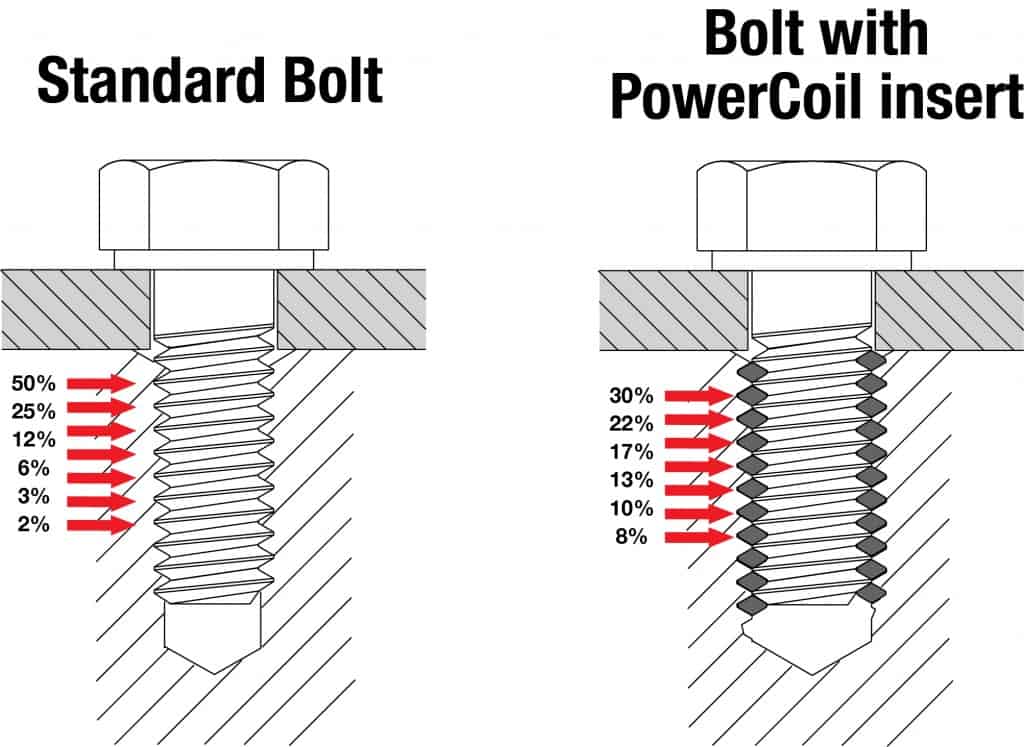In a previous article we discussed some of the features of PowerCoil wire thread inserts. Now we want to go deeper into some of the specific advantages, particularly strength, elimination of stress, wear resistance, corrosion protection.
Strength
Due to their flexibility, wire thread inserts create internal threads that have a much improved distribution of residual stress loading when compared with conventional tapped holes, where 75% of the shearing forces are carried by the first three threads in the tapped hole. The flexibility of wire thread inserts helps to compensate for pitch and flank angle errors, inherent in normal tapped holes, and significantly enhances the load bearing capacity by deflecting the residual forces into a helical hoop stress which is dispersed into the wall of the tapped hole. This enables the design to be confidently based on the bolt strength utilising smaller and shorter threads even when used in low strength materials.
The high tensile coils of a wire thread insert undergo a diameter reduction during installation. The outward spring-like force of the coils “locks” the insert into place.
Each coil can flex independently to contact the greatest amount of parent material thread surface. Both static and dynamic load bearing capabilities are improved.
Eliminate Stress
Virtually no stress is introduced into the parent material because there is no staking, locking, swaging or keying in place. The outward “spring action” of the insert holds it in place.
Wear Resistance
The combination of material hardness and the brilliant surface finish of wire thread inserts creates internal threads in which wear due to thread friction is virtually eliminated. This is of particular value in applications requiring repeated assembly & disassembly. The low frictional coefficient ensures that virtually all of the applied assembly torque is converted into clamping load. Thus providing threads that stay tight.
Corrosion Protection
The 18/8 austenitic stainless steel wire used in PowerCoil inserts resists corrosion under normal environmental conditions. Galvanic action within the thread assembly is reduced, increasing the life of the fastening assembly.
Galvanic corrosion is most significant form of corrosion affecting inserts and fasteners. Galvanic corrosion occurs when dissimilar metals are in contact in the presence of an electrolytic solution. All metals exhibit different degrees of “activity” or “nobility” and can be arranged in a galvanic series of increasing activity. Gold and platinum are most noble while zinc and magnesium are most active. The most common electrolytic solution encountered is ordinary water. Seawater or salt spray is more damaging because of high concentrations of dissolved salts.
The best way to preclude galvanic corrosion is to use similar potential metals and eliminate the electrolyte conductor. The active stainless steel of PowerCoil wire thread inserts is not passivated. This minimizes the possibility of galvanic corrosion occurring when they are installed in aluminum or magnesium parent materials.
Some additional precautions for reducing galvanic corrosion are:
- Isolate the fasteners from the electrolyte. This can be done through gasketing or sealing.
- Specify cadmium plated inserts. The cadmium plate provides a sacrificial barrier against corrosion. In addition, the cadmium plate has lubricating properties that minimize galling when stainless steel screws are used.
- Apply corrosion inhibiting pastes or compounds to the screw. These include zinc chromate primer (MiL-P-8585) and strontium chromate primer (MiL-P-23377). Note: Pastes applied to the PowerCoil Thread Insert can become trapped between the wire and the hole and cause loss of proper tolerance. It is therefore recommended to apply the paste only to the screw, not the insert. If zinc chromate primer is applied to the tapped hole it should be thinned and applied sparingly. The insert should be installed while the primer is still wet.
- Specify a dry film lubricant such as molybdenum disulphide on the inserts. This provides a secondary barrier against corrosion.
- Where practical or where it will not interfere with the completed assembly, the external joint should be coated with a suitable paint.
The next article in this primer series will delve into how to select the correct insert length, as well as different materials and coatings.


Comments are closed.